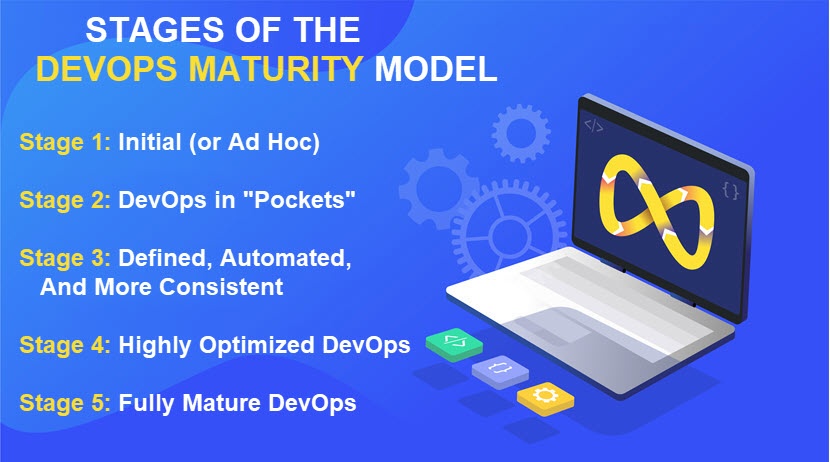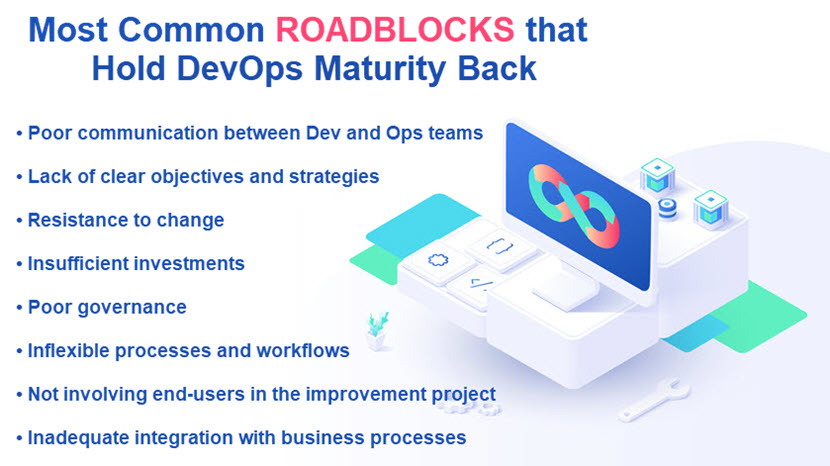DevOps Maturity Model
While the benefits of adopting DevOps are obvious (faster time-to-market, fewer bugs in production, improved code quality, etc.), the transition from traditional software development is rarely smooth and free of setbacks.
If you're struggling with adopting or making the most out of DevOps, your first step should be to assess current software delivery processes against a DevOps maturity model.
This article is an intro to DevOps maturity models and the way these frameworks enable companies to make informed decisions when adopting or upgrading DevOps processes.

What Is the DevOps Maturity Model?
The DevOps maturity model is a framework that outlines the general stages an organization goes through when adopting DevOps principles and practices. These models help determine how far along organizations are on their DevOps journey and what steps they should take to reach higher levels of DevOps maturity.
Maturity models evaluate various aspects of your DevOps (degrees of silos, speed and quality of releases, adherence to principles, collaboration levels, use of automation, tool stacks, etc.). This analysis helps companies:
- Assess and benchmark current DevOps capabilities and practices.
- Identify the desired maturity level.
- Prioritize areas for improvement.
- Make a roadmap for reaching higher levels of maturity.
- Learn about DevOps best practices, security measures, and relevant metrics.
Once you know your position in a maturity model, the idea is to make changes to your IT until you mature into a higher stage. The DevOps maturity model offers guidance at each step, explaining how to "move up" and reach the next phase.
Remember that companies mature at different speeds even if they use the same framework. The pace of change is not vital — it is far more critical that you:
- Recognize areas where your team is falling short and begin to shore up those weaknesses.
- Reinforce your team's strengths and build on them to improve DevOps procedures.
Our CEO recently wrote about cloud maturity models that guide companies through the five stages of adopting cloud computing.
What Makes a DevOps Maturity Model?
Here's what you should expect to find in any top-tier DevOps maturity model:
- Assessment criteria. A set of standards against which you evaluate the maturity of DevOps practices.
- Maturity levels. The different stages of DevOps adoption organized in sequential order. Most models have five different maturity levels, although you'll occasionally run into frameworks with one or two extra stages.
- DevOps processes and practices. A breakdown of techniques that support DevOps, accompanied by their placement in the model. Expect guides to release management, task automation, security practices, CI/CD, infrastructure-as-code (IaC), etc.
- Relevant metrics. A list of key performance indicators (KPIs) and metrics for measuring the state of your DevOps (e.g., deployment frequency, mean time to recovery, change failure rate, etc.).
- Culture guides. Guidelines for evaluating the company culture and alignment with DevOps principles. Usual inclusions are tips on improving communication, feedback, and collaboration.
- Go-to tools and tech. Most high-end models have a list of appropriate tools and technologies that support DevOps initiatives. Expect up-to-date version control systems, CI/CD tools, automation platforms, and containerization tools.
- Roles and responsibilities. An outline of who's responsible for what in a DevOps team (ownership of processes, go-to staff members for disaster recovery, QA tasks, designing CI/CD pipelines, responding to threats, ensuring high availability, etc.).
Our article on DevOps roles and responsibilities offers an in-depth look at all the essential duties within a high-performing DevOps team.
5 Transformation Stages of the DevOps Maturity Model
Different maturity models have slightly different stages and criteria for each phase depending on company size, industry, and goals. However, most frameworks lead users through a similar progression—let's look at the most common stages of DevOps maturity.

Stage 1: Initial (or Ad Hoc)
This stage is the starting point of the DevOps journey. DevOps-like practices are entirely missing or so disjointed that stakeholders have no idea about their use.
Organizations at this stage suffer from a range of software development problems (limited inter-team collaboration, too many manual tasks, buggy releases, lengthy approval processes, etc.).
Here are the main characteristics of organizations at Stage 1 of DevOps maturity:
- Development, operations, security, and product owners operate in silos, and each team has different incentives and priorities.
- Ops specialists wait for developers to hand over applications alongside deployment manuals.
- Software development relies on an old-school waterfall approach.
- Most (if not all) build steps are manual.
- Release cycles focus on milestones and not on user feedback or market changes.
- Teams spend more time and effort on putting out fires than adding value to the product.
- The team creates and updates infrastructure manually, which is time-consuming and prone to errors.
- Every server (physical or virtual) requires individual attention.
- Testers work manually and individually, which turns testing into a considerable bottleneck.
- Security checks are minimal and occur only days before the go-live of a new release.
- The company typically learns about an outage from users rather than in-house alerts.
The key to getting out of this stage is to educate teams about DevOps practices and remove their resistance to change. Consider forming a temporary working group to steer software delivery practices out of silos and start making positive changes to workflows (involve Ops earlier in the SDLC, encourage the use of configuration management tools, add automated tests, etc.).
Stage 2: DevOps in "Pockets"
Companies at this stage have established some DevOps practices and started to emphasize inter-team collaboration and automation. Workflows are becoming more streamlined, but most processes lack clear definitions and guidelines.
Here are the main traits of organizations at Stage 2:
- While developers and Ops are not working together full-time, the two teams collaborate on small-scale projects.
- Teams tend to ship big features that are challenging to manage and test.
- Agile practices during software delivery enable teams to focus more on business and user value during project planning.
- Teams use version control to manage environments and their configurations.
- Developers struggle to break bigger services into microservices.
- Changes to the product are becoming less surprising to all involved teams.
- Teams rely on automation to reduce the risk and stress of releases, but many staff members follow the "automation for automation's sake" mantra.
- The security team still works independently, but testing is no longer minimal or an afterthought, so unit, integration, and end-to-end testing occur earlier in the development process.
- Companies rely on site monitoring to get alerts about interruptions as soon as they impact the user.
- Operations staff members must manually intervene when things go wrong in production.
The key to getting out of this stage is to focus more on automation and consistency. The right foundations are there, but the lack of repeatability is holding your DevOps back.
Stage 3: Defined, Automated, And More Consistent
This stage in the DevOps maturity model requires well-defined and standardized processes across the Dev and Ops teams. Additionally, teams focus on:
- Using automation to eliminate repetitive, error-prone, and time-consuming manual tasks.
- Optimizing continuous delivery, deployment, and integration.
- Nurturing a culture of collaboration and feedback.
Here are the main characteristics of organizations at Stage 3 of DevOps maturity:
- Ops staff and engineering regularly converse about upcoming code releases and bug fixes.
- Security team members join meetings well before deployments and partake in design and architecture conversations.
- Teams focus on frequent deployments with small, incremental changes.
- Releases are still a major event, so the team typically bundles groups of unrelated features into big projects.
- Concepts of minimum viable products and technical debt are still foreign.
- Deployments never take the operations team by surprise as they work on configuration changes while engineers develop the feature.
- A range of processes occurs automatically to ensure repeatability and standardization (e.g., database changes, integration tests, monitoring, non-production deployments, etc.).
- Developers make full use of self-service cloud computing resources.
- Teams integrate security scans throughout the DevOps pipeline, making a conscious effort to shift tests left of deployment.
- The team relies on clear documentation and release notes.
The key to moving to the next stage is to improve current processes and shift away from measuring internal benchmarks in favor of end-user experience.
Stage 4: Highly Optimized DevOps
Companies at this stage focus on measuring success according to the user experience and business objectives.
Here are the main traits of being at Stage 4 of the DevOps maturity model:
- Ops and development teams work closely with project management and security teams when planning improvements to the product.
- Developers and Ops team embrace product-oriented thinning.
- The deployment process is almost entirely automated, with only one or two manual interventions.
- Code releases are not distinct events but a series of continuous, incremental software updates.
- Development and operations work in the same technical environment, so developers always consider Ops-related aspects of releases (and vice versa).
- The continuous integration system works well 90+ percent of the time.
- DevOps aligns with and supports the company's broader IT strategy plan.
- Agile processes mature into lean practices (blameless post-mortems, gameday exercises, value stream mapping, etc.).
- Minimum interruptions to end-user experience.
- The team uses MVPs and tech debt as strategies to speed up releases.
- Company is comfortable with chaos engineering and pen testing.
- The team relies on soak tests to anticipate product performance prior to deployment.
- Teams analyze various metrics to quantify the impact of releases on overall performance.
- Systems scale automatically to adjust to current demands and avoid problems like network latency or infrastructure failure.
- Security checks are a built-in feature of the development workflow, and there's a broad suite of high-quality automated tests.
- The team relies on continuous monitoring to actively track problems and identify root causes.
If you're at this point, your company is making full use of DevOps. The only thing keeping you out of the final stage is instilling a culture of continually using data-driven insights to optimize processes.
Stage 5: Fully Mature DevOps
Organizations at this stage enjoy the highest level of DevOps maturity, and the team continuously optimizes the pipeline through data-driven insights.
In addition to practices from Stage 4, companies at Stage 5 of DevOps maturity also have the following characteristics:
- Code changes pass through the pipeline and end up in production with zero human intervention.
- The team deploys multiple times a day with certainty and minimal risk.
- Insecure or non-compliant code never reaches production.
- Each business unit is a self-sufficient full-stack team of experts across all the necessary tech and process domains.
- Max uptime and no interruptions to customer experience.
- Ideas go to production in hours or days.
- The use of real-time data enables teams to make rapid and informed decisions.
- High levels of collaboration between developers, operations, and security lead to DevSecOps.
- The company encourages innovation and experimentation.
There's no moving past stage 5, but companies that fail to focus on continuous optimizations risk going a step or two back in the DevOps maturity model.
Benefits of DevOps Maturity
Evaluating your position in a DevOps maturity model leads to a range of business benefits. These frameworks enable you to:
- Determine how well your team is using DevOps principles.
- Identify areas for improvement and make informed decisions about taking your DevOps to the next level.
- Create more focused and effective progression strategies free of low-value objectives.
- Track your DevOps progress and allocate resources more effectively.
- Get insights into best practices concerning DevOps security, release cycles, testing, team culture, staff management, etc.
- Learn about the market's best DevOps tools.
- Keep up with the latest DevOps trends and use cases.
- Get a better sense of industry standards and see how your operations compare to peers and competitors.
Investing time and money into moving up the DevOps maturity model is also highly beneficial. Each subsequent stage leads to faster time-to-market, improved reliability, reduced IT costs, and better-performing teams.
Learn the difference between SRE and DevOps, two closely related IT practices that speed up development and help companies create high-quality software.

How to Measure DevOps Maturity?
Here are the go-to metrics for measuring DevOps maturity:
- Time-to-market (the time a team takes to go from ideation to launch).
- Lead time (the time between code commit and deployment).
- Deployment frequency (how often the team deploys in a given period).
- Code quality (various metrics that evaluate the state of code, such as complexity, coverage, and review feedback).
- Code deployment success rate (percentage of successful deployments).
- Change failure rate (percentage of deployments that lead to a failure).
- Rollback rate (percentage of deployments the team rolls back).
- Error budget (the acceptable rate of errors and failures in production).
- Availability (percentage of time the system is fully operational and available to end-users).
- Scalability (a system's ability to handle an increased load without performance issues).
- Time-in-stage (the average time a team takes to complete each stage of the software development lifecycle).
- Code review feedback loop time (how long it takes to get feedback and implement changes in response to code reviews).
- MTTR (Mean Time to Recovery, the average time a team takes to recover from a failure).
- MTTD (Mean Time to Detect, the average time it takes to detect a problem).
- MTTA (Mean Time to Acknowledge, the average time a team takes to acknowledge and start working on a problem).
There are also a few less-quantifiable metrics, including:
- User feedback and satisfaction.
- Collaboration levels between different teams (namely developers and ITOps, but also security, compliance, project management, etc.).
- Communication between IT teams and executives.
- The state of DevOps-related documentation.
Learn more about DevOps metrics and see how to extract valuable information from those KPIs.
Get More Out of Your DevOps Initiative
While a DevOps maturity model is far from guaranteed success, such frameworks help map your adoption journey, avoid common roadblocks, and drive decision-making in the right direction. You get a clear overview of where your DevOps is and where it's falling short, which enables you to correct mistakes and maximize your ROI.